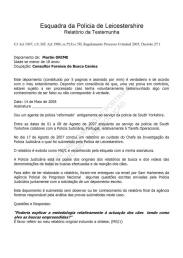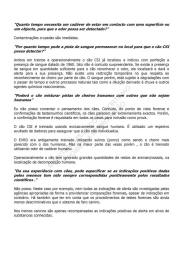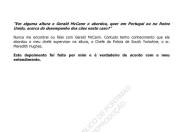|
21 to 25 Witness
statement of Martin Grime
2008.05.14 |
|
03-CARTAS ROGATORIA
5 Pages 21 to 25 |
|
TRANSLATIONS BY CAMERINA32 |
|
cr3_21 |
 |
|
cr3_22 |
 |
|
cr3_23 |
 |
|
cr3_24 |
 |
|
cr3_25 |
 |
Translation
DVD Rogatory Letters 3rd volume
Martin Grime
Dated May 14 2008
I am a retired police offer,
previously at the service of the
South Yorkshire police. Between
August 1-8, 2007, and while working
for the South Yorkshire police, I
collaborated with the Judicial
Police, Portugal, as regards their
Operations Task Force.
On the 17th of August 2007, I
completed a report for the Head of
Investigations of the Judicial
Police, which was submitted by the
Leicestershire Police. This report
is exhibited as MG/1 and identified
by the label bearing my signature.
The Judicial Police is in possession
of the originals of the search
reports and the videos showing all
searches performed and the reaction
of the dogs. In addition to the
report, Sam Harkeness of the
Progresso National Police Agency
sent me by email several written
questions sent by the Judicial
Police together with a request for a
written deposition. This deposition
was submitted without me having seen
or having knowledge of the final
report from the forensic agency
responsible for analyzing the
evidence submitted in this case.
Questions and Answers:
'Could you explain the methodology
regarding the performance of the
dogs bearing in mind the searches
that were performed''
Please refer to my original report
included in the summary (MG/1).
'Could you provide a detailed
summary of the orientation capacity
of the dogs, as well as an
interpretation of the indications
provided by them in the specific
cases''
Please refer to my original report
included in the summary (MG/1).
The interpretation of any alert is
given when the dogs recognize a
specific odour as a result of a
response to the behaviour for which
they were trained. This response
must then be submitted to a forensic
examination in order to draw
conclusions.
'In order to establish the accuracy
of the dogs' performance with
respect to the alerts given when
recognizing blood and a body, to
what extent are these indications
viable in this particular case''
The dogs' alerts are to be
considered as an area of interest or
possible testing. When specific and
reliable this can only be measured
for confirmation. In this case in
particular, where the dogs alerted
there was confirmation by positive
results from the forensic
examinations. It is the
investigators' responsibility to
apply the results of the forensic
analysis to the suspects, witnesses
and crime scenes.
'Based upon the dogs' behaviour, is
it possible to distinguish between a
strong signal and a weak signal'.
The dogs' passive CSI alert provides
an indication as per their training
and does not vary. They only give an
alert when they are 'positive' that
the target of the odour is present
and immediately accessible. If they
had any doubts they would not give
an alert. EVRD gives an alert by
means of a vocal bark. The
variations in the vocal alert can be
explained by many reasons such as
'thirst' or 'lack of air due to
effort'. Every alert can be subject
to interpretation, it has to be
confirmed. The signals of an alert
are only just that. Once the alert
has been given by the dog, it is up
to the investigator/forensic
scientist to locate, identify and
scientifically provide the evidence
of DNA, etc.
'Can you confirm if the signal given
regarding the stuffed toy
corresponds to a concrete alert of
detection of a cadaver, or a mere
trick played by the dog''
The dogs were not taught any
'tricks'. EVRD 'signalled' the toy,
which at my request was retained by
the Judicial Police for future
forensic analysis. I have no
knowledge of the results of any
forensic analysis on the toy.
'With respect to the cadaver odour
on Kate's clothes, could it be
undoubtedly affirmed that those
clothes had been in contact with a
cadaver'
OR
Could the alert have been given
because the clothes had been in
contact with other items of
clothing, surfaces or objects that
could previously have touched a
cadaver, thereby allowing the odour
to be transferred''
There is always a possibility of
contamination of odours by
transferral. EVRD does not make a
distinction; he responds with a
certain behaviour for which he was
trained when he recognizes an odour.
He does not identify the reasons for
the presence of the odour nor does
he identify suspects. Forensic
confirmation and specialized
investigation methods will determine
the reasons and the suspicions. In
order to undoubtedly affirm there
must be a confirmation of the alert
signals made by the dog.
'The dog EVRD also alerts to blood
from a live human being or only from
a cadaver'
The dog EVRD is trained using whole
and disintegrated material, blood,
bone tissue, teeth, etc. and
decomposed cross-contaminants. The
dog will recognize all or parts of a
human cadaver. He is not trained for
'live' human odours; no trained dog
will recognize the smell of 'fresh
blood'. They find, however, and give
the alert for dried blood from a
live human being.
'Taking into account the signals of
CSI, could the dog alert to other
biological fluids''
The dog that alerts to human blood
is trained exclusively for this
purpose, and includes its
components, plasma, red cells, white
cells and platelets. Given the
nature of the training, the dog will
not alert to urine, saliva, semen
sweat, nasal secretion, vaginal
secretion or human skin unless these
are mixed with blood. The components
of blood are approximately:
Red cells 40-50%
Plasma 55% (of which 95% is water)
White cells
Platelets
DNA can only be removed from white
cells.
This would suggest that, of the
samples signalled by the dog looking
for human blood, approximately 5%
are available for DNA tests.
'Is there any chance, however
remote, of any confusion'
The dogs do not get confused. They
transmit a behavioural response
inspired by the recognition of the
odour for which they were trained.
'How long does a cadaver have to be
in contact with a surface or an
object for the odour to be
detected''
Cross-contamination is immediate.
'How long can a trace of blood
remain at a scene and be detected by
the CSI dog''
During both training and operations,
the CSI dog correctly located and
signalled the presence of blood from
1960. This is not at all surprising.
If enough blood is present so that
the dog can recognize its odour, he
will locate it and alert to its
presence. There is no time
restriction as regards the
recognition of the odour by the dog.
Blood, however, is subject to
deterioration such as time and other
natural processes such as dilution
due to rain and other reactive
chemical agents.
'Can the dog mix up traces of human
odours with others that are
non-human''
I cannot comment on what the dogs
think. However, from a forensic
point of view and from confirmations
of scientific testimonies, the dogs
appear to be extremely exact. But,
forensic confirmation is required in
all cases so as to be included as
proof. The CSI dog is trained using
only human blood. And using a wide
spectrum of donors to ensure that
the dog does not individualize them.
EVRD used to be trained using swine
(pigs) as their odour is the closest
to that of humans. But most of the
time, however, the dog was trained
using the odour of a human cadaver.
Operationally, the dog has ignored
large amounts of animal
remains/bones when locating human
decomposition.
'Based upon your experience with the
dogs, can you specify whether the
positive signals given by them have
always matched the scientific
results''
I cannot. In this case, for example,
not all the alert signals have been
investigated by the appropriate
agencies in order to provide
forensic comparations, in spite of
indications to the contrary. It also
should be taken into account that
the procedures for forensic testing
are still less discriminating than
the system of dogs' smell.
During training, the dogs are barely
rewarded for positive alert signals
regarding targets of known
substances.
'At any time, did Gerald McCann
address, either in Portugal or the
United Kingdom, the performance of
the dogs in this case''
I never met nor spoken to Gerald
McCann. However I do know that he
addressed my head supervisor at the
time, the South Yorkshire Head of
Police, or Mr. Meredith Hughes.
This deposition was made by me and
is true according to my
understanding.
|
|
---> 114 to 115
IX
- Interviews to MARK HARRISON and MARTIN GRIME |
|
CR 2 page 114 to 115 |
|
Questions for Martin Grime from the Letter of
Request:
IX - Interviews to MARK HARRISON and MARTIN GRIME, who were in
charge of the searches undertaken by the specialist dogs, and
who shall be notified by the Requested Authority.
MARTIN GRIME should be asked the following questions :
* Could you explain the methodology regarding the performance of
the dogs in the scope of the undertaken searches ?
* Could you provide a thorough description of the dogs' skill
and orientation, as well as an interpretation of the dogs'
indications in the specific cases ?
* Aiming at determining the reliability of the canine
performance, in what concerns the alerts given to blood scent
and to dead body scent, how reliable are those indications in
this particular case ?
* From the behaviour of the dogs, is it possible to distinguish
between a strong alert and a soft alert ?
* Can you say whether the indication given to the cuddly toy
corresponds to a concrete alert to dead body scent or to a mere
dog playing trick ?
* In what concerns the cadaver scent on KATE's clothing, could
it be undoubtedly stated that those clothes had been in contact
with a dead body ? Or could the alert have been given even if
those clothes had been in contact with other pieces of clothing,
surfaces or items which could have had previously touched a dead
body, thus allowing for secent transfer ?
* Does the EVRD dog ( dead body scent dog) also alert to blood
traces coming from a living person or from a dead body ?
* In what concerns the indications given by the CSI dog ( human
blood detecting dog), can this dog alert to other biological
fluids ? Isn't there a chance, even a tiny one, of some
confusion ?
* How long does a cadaver need to be in contact with a surface
or an item, so that the scent can be indicated ?
* How farther can a blood trace date back in time, so that the
CSI dog gives an indication ?
* Can the dogs mix up scents from human and non-human traces ?
* From your experience as a dog Handler, can you specify whether
the dog's positive indications have always been corroborated by
positive scientific results ?
* Did Gerald McCann ask you, at any time, in Portugal, or in the
United Kingdom, any questions about the performance of the dogs
in this case ?
* Any further questions deemed useful, necessary or pertinent in
view of the previous replies. |
|
TO HELP KEEP THIS SITE
ON LINE PLEASE CONSIDER
|
|
|
|
|
|